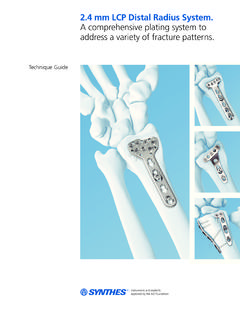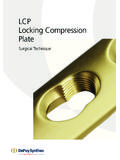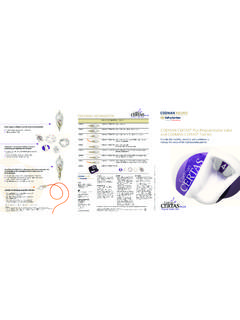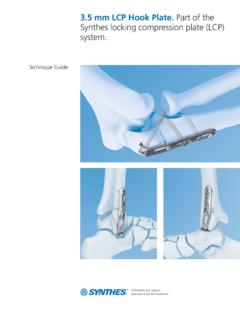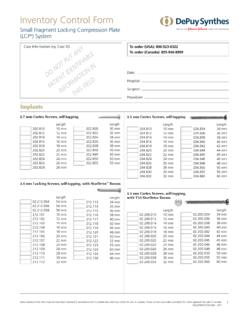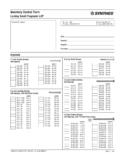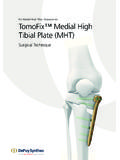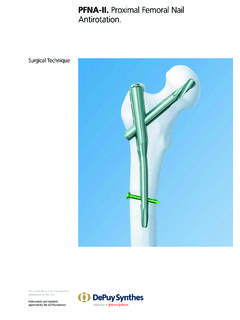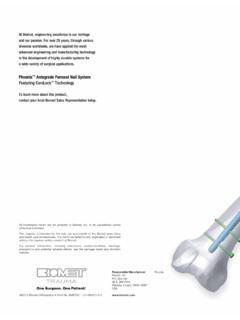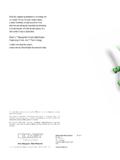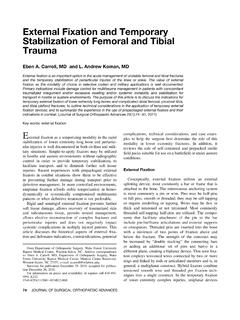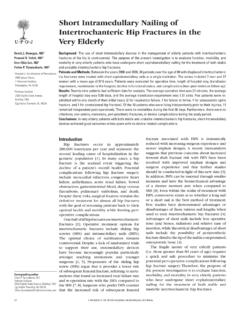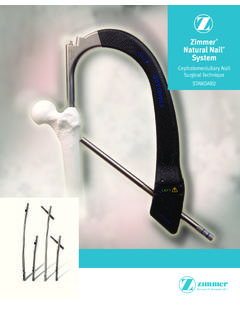Transcription of LCP Locking Compression Plate - synthes.vo.llnwd.net
1 Surgical TechniqueThis publication is not intended for distribution in the and implantsapproved by the AO Locking Compression PlateImage intensifier controlThis description alone does not provide sufficient background for direct use of DePuy Synthes products. Instruction by a surgeon experienced in handling these products is highly , Reprocessing, Care and MaintenanceFor general guidelines, function control and dismantling of multi-part instruments, as well as processing guidelines for implants, please contact your local sales representative or refer to: general information about reprocessing, care and maintenance of Synthes reusable devices, instrument trays and cases, as well as processing of Synthes non-sterile implants, please consult the Important Information leaflet (SE_023827) or refer to: Locking Compression Plate Surgical Technique DePuy Synthes 1 Table of ContentsIntroduction LCP Locking Compression Plate 2 LCP Metaphyseal Plates 4AO Principles 5 Intended Use, Indications and Contraindications 6 Surgical Technique Standard Plate Technique 8 Insert Self-tapping Locking Screws 15 Insert Self-drilling.
2 Self-tapping Locking Screws 24 Indirect Reduction with Locking Screws 26 Drilling with the LCP Universal Drill Guide 29 Insert LCP Spacers 31 Metaphyseal Plates for extra articular fractures 32 Examples of the Combination Technique 36 Remove the Implant 37 Product Information Basic LCP Plates 38 Screws 49 Spacers 52 Cerclage 53 Instruments 55 MRI Information 60 StardriveHex drive2 DePuy Synthes LCP Locking Compression Plate Surgical TechniqueSystem overviewLCP Locking Compression PlateAngular stable implantAngular stable support of fragments regardless of bone qualityMay reduce the risk of primary and secondary loss of reduction even under high dynamic loadingLimited Plate -periosteum contactLocking screws provide hold also in osteoporotic bone and in multiple fragment fracturesStability of the implant and the con-struct: Locking screws can be placed in each Locking hole of the plateBecause the screws are tightly locked in the Plate : There is no tension on the bone Compression is reduced between the Plate and bone The periosteum is undamaged and circulation is retainedThe Plate does not have to be precisely shaped to the bone to provide stabilityMinimally invasive surgery (MIS).
3 The soft tissue and the wound hematoma are treated gently Circulation is maintainedABLCP Locking Compression Plate Surgical Technique DePuy Synthes 3 Reduction maintained under a loadLCP combi-holeStable bridging of comminuted fracturesThe stable Plate -screw connection decreases secondary loss of reduction in the epiphyseal and metaphyseal regions The screws are locked in the Plate , and the physiological load (F) is transferred from the bone to the plateThe fragments are fixed in their reduced position without regard to the Plate model (internal fixator)The bone fragments are fixed in the position assumed at the time the screws are lockedA Stable Plate -screw connection Locking screws reduce screw loosening Excessive torque is not applied to the cortical bone The conical screw head may help to insert the screw B Compatibility The proven dynamic Compression hole allows the use of all standard (Cortex or Cancellous Bone) screws Self-tapping Locking screws Use after precisely measuring the length (metaphysis) Monocortical or bicortical use Not necessary to separately tap thread Self-drilling Locking screws Use without having to precisely measure the length (diaphysis) Only for monocortical use Tapping and predrilling are unnecessaryStandard (Cortex or Cancellous Bone)
4 Screws Dynamic Compression is created by the eccentric insertion of the stan-dard screws (analogous to LC-DCP)4 DePuy Synthes LCP Locking Compression Plate Surgical TechniqueLCP Metaphyseal Plates. For extra-articular combi-holes allow uncompromising combinationsThe combi-hole allows an internal Plate fixation using stan-dardscrews, angular stable Locking screws, or a combination of both. This takes into account the most diverse intraopera-tive stability allows for improved fixationThe angle- and axis-stable Locking screws may prevent loss of reduction under load. A precise anatomical contouring of the Plate is unnecessary when using this system as a Locking internal of Plate contouring due to thinned Plate profileThe Plate design facilitates anatomical contouring consider-ably, whilst taking into account the distinctive features of the metaphyseal bone area ( complex bone shapes, thin soft tissue envelope).
5 Extra-articular fixation with the advantage of angled Locking screwsThe two distal holes in the thinned area of the Plate , which are angled at 11 towards the centre of the Plate , may allow an application of the Locking screws in the epiphyseal design features Bullet nose Plate tip for application of the minimally invasive surgical technique. Temporary fixation can be achieved through the suture hole. Improved vascularization of the periost due to Plate undercuts that reduce the Plate -to-bone contact. The elongated hole in the shaft are designed to allow fine tuning of the reduction in the longitudinal Metaphyseal Plate Metaphyseal Plate 1 12:084 DePuy Synthes Expert Lateral Femoral Nail Surgical TechniqueAO PRINCIPLESIn 1958, the AO formulated four basic principles, which have become the guidelines for internal fixation1, M ller ME, M Allg wer, R Schneider, H Willenegger.
6 Manual of Internal Fixation. 3rd ed. Berlin Heidelberg New York: Springer. R edi TP, RE Buckley, CG Moran. AO Principles of fracture Management. 2nd ed. Stuttgart, New York: Thieme. reductionFracture reduction and fixation to restore anatomical , active mobilizationEarly and safe mobilization and rehabilitation of the injured part and the patient as a fixationFracture fixation providing abso-lute or relative stability, as required by the patient, the injury, and the personality of the of blood supplyPreservation of the blood supply to soft tissues and bone by gentle reduction techniques and careful Locking Compression Plate Surgical Technique DePuy Synthes 5AO Principles 1 M ller ME, Allg wer M, Schneider R, Willenegger H. Manual of Internal Fixation. 3rd ed. Berlin, Heidelberg, New York: Springer. 1991. 2 R edi TP, Buckley RE, Moran CG.
7 AO Principles of fracture Management. 2nd ed. Stuttgart, New York: Thieme. fixationFracture fixation providing absolute or relative stability, as required by the patient, the injury, and the personality of the reductionFracture reduction and fixation to restore anatomical , active mobilizationEarly and safe mobilization and rehabilitation of the injured part and the patient as a of blood supplyPreservation of the blood supply to soft tissues and bone by gentle reduction techniques and careful 1958, the AO formulated four basic principles, which have become the guidelines for internal fixation1, DePuy Synthes LCP Locking Compression Plate Surgical TechniqueIntended Use, Indications and ContraindicationsIntended Use Locking Compression Plate (LCP) Implants are intended for temporary fixation, correction or stabilization of bones in various anatomical Surgical Technique applies to the Depuy Synthes LCP Locking Compression Plate Systems and product lines listed below, which include but are not limited to the following indications:IndicationsThe indications for each system will be presented Fragment plates ( ) LCP Plates of small bone fragments using the five standard AO plating principles (buttress Plate , neutralization Plate , tension band Plate , bridge Plate , Compression Plate ).
8 LCP Reconstruction Plates of small bone fragments using the five standard AO plating principles (buttress Plate , neutralization Plate , tension band Plate , bridge Plate , Compression Plate ).LCP T-Plates of small bone fragments using the five standard AO plating principles (buttress Plate , neutralization Plate , tension band Plate , bridge Plate , Compression Plate ). fracture fixa-tion and fixation after osteotomies, malunions, non-unions; including but not limited to distal radius, proximal and distal tibia, proximal humerus, Cloverleaf Plates For medial buttressing of comminuted distal tibial fractures For comminuted humeral head fracturesLCP One-third Tubular Plates The LCP One-third Tubular Plates are indicated for plating of fractures of long and small bones. The Plate should only be used for load-sharing purposes, buttressing, tension banding, neutralization or Methaphyseal LCP Metaphyseal Plates are indicated to fix extra-articu-lar fractures in the metaphyseal area that can extend into the shaft area.
9 The mm plates are indicated to fix fractures of the distal humerus and distal Locking Compression Plate Surgical Technique DePuy Synthes 7 Large Fragment plates ( )LCP Methaphyseal LCP Metaphyseal Plates are indicated for Extra-articular fractures of the metaphyseal area that extend into the shaft plates are indicated to fix fractures of the proxi-mal humerus and distal Narrow PlatesLCP T-Plates Broad PlatesLCP Broad Curved PlatesLCP Reconstruction Plates L-Buttress Plates T-Buttress Plates general the LCP Generic Plates & Instruments (Large Frag-ment) are indicated for the osteosynthesis of fractures at the Femur, Tibia, Humerus and Pelvic at proximal, distal and shaft existing designs of the Synthes of the large fragment plates (standard plates DCP, LC-DCP) have been retained. The same indications apply for LCP plates as for the correspond-ing standard the case of metaphyseal fractures, comminuted fractures and osteoporotic bone, the clinical results can be improved by the angular stable screw/ Plate specific contraindications.
10 8 DePuy Synthes LCP Locking Compression Plate Surgical TechniqueStandard Plate Technique1 Reduce the fractureReduce the fracture under the image intensifier. As needed, provide fixation with Kirschner wire or reducing the fracture indirectly using the Plate by means of standard screws (for lag screw technique: to generate inter-fragmentary Compression , use cancellous bone or cortical bone screws, see examples of the Combination Technique on page 36).Precautions: Instruments and screws may have sharp edges or moving joints that may pinch or tear user s glove or skin. Handle devices with care and dispose worn bone cutting instruments in an approved sharps container. LCP Locking Compression Plate Surgical Technique DePuy Synthes 92 Bend the plateInstrumentsSmall fragment Bending Iron for Plates to (for use with ) Bending Iron for Plates to (for use with ) Bending Pliers for Plates to Bending Pliers for Reconstruction Plates and fragment Bending Bending Pliers for Plates Bending Iron for LC-DCP and DCP (two required) Bending Iron for Reconstruction Plates and contour the LCP Plate to the anatomy using the appropriate bending instruments (as for standard plates), especially in the case of joint : Reverse bending or use of the incorrect instrumentation for bending may weaken the Plate and lead to premature Plate failure ( breakage).
